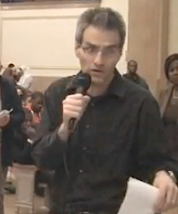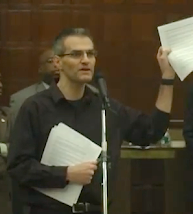VI. For a militant, progressive, democratic UFT: a democratic UFT is a key to a strong union
One of the major goals of a movement seeking change in the union is to take on the task of democratization — setting up structures and procedures that will give the rank and file the opportunity to have direct and constant ability to formulate union policy.
On paper the UFT is more democratic than many unions, but in practice what we see is a well-oiled political machine:— The least number of people make the decisions.As soon as their monopoly of power is challenged, the union’s officers change the rules of the game. Some years ago, when members elected an opposition candidate for high school vice-president and came very close in the junior high division, the officials changed the voting procedures for divisional leaders, turning them into at-large positions. They eliminated elections for district representatives who leave mid-term and fill these positions with appointments by the presidents. District reps play key roles for the union bosses by rewarding friendly chapter chairpersons and punishing dissident chapters through the delivery or withholding of services. They intervene in chapter elections by stealthily supporting candidates against known dissident chapter chairpersons and sometimes even delegates.
— The rank and file are deliberately kept unaware of what is going on in regards to most issues.
— There is a conscious attempt by the president and other officers to limit rank and file participation in meetings, discussions and the decision-making process, with union structures set up to enforce this policy.
— There is a consistent effort by union officers on all levels to stifle dissent and opposition. They go so far as to modify or violate previously existing democratic practices and procedures in order to do this.
— Measures are taken at the Delegate Assembly and in citywide voting to ensure the desired results.
If you’re looking for democracy within Unity Caucus, however, you won’t find it there either. Caucus discipline is maintained through a system of rewards and patronage: a career ladder within the union, out-of-classroom jobs in schools (in the past at district offices and the Central Board), assistance in getting good administrative jobs, and transfers to desirable schools. It’s the Success for Unity Caucus Faithful Program. Simply put, dissension within Unity Caucus is not tolerated. There has rarely been a delegate elected on the Unity Caucus slate who has voted against the Unity Caucus position at a NYSUT or AFT convention. Unity Caucus utilizes its well-disciplined base within the UFT to control the state and national unions so that it can implement its political agenda.
Our union officers know that an informed, involved membership with a greater voice would challenge their policies and would also vote them out of office. That’s why they work so hard to keep us from knowing what’s really going on and having regular access to viewpoints that differ from theirs.
Key structural changes are needed to bring greater democracy to our union so that the membership can decide what their union should stand for.
1. Divisional elections for divisional vice-presidents (i.e., high school members alone should vote for high school VP, vocational high school members for vocational high school VP, and so on).
In 1994 Unity Caucus ended the practice of people within a division voting exclusively within their division for their own vice-president because they wanted to make sure no VP would ever again be elected from an opposition group, as had happened a few years earlier. Unity changed the procedure to make the balloting for vice-presidents at large. That means that all the members of the UFT vote for divisional vice-presidents, even if they don’t work in that division. In addition, retirees, who in the last election cast 35% of all votes cast, also vote for the high school, junior high school, and elementary divisional vice-presidents, which means that non-working members have a tremendous influence over who will represent working teachers.
2. Retirees should not vote for UFT officers, who are responsible for negotiating the contract for active members.
The NYS Public Employees Relations Board has ruled that retired members of the UFT are not members of our bargaining unit. Therefore, retirees should not vote for those who represent active members in collective bargaining. There should be a special retiree VP who handles retiree issues and is elected exclusively by retired UFT members.
3. Retirees should vote for three teacher members of the Teachers’ Retirement System Board.
State law restricts TRS membership to in-service members and does not allow retirees to serve as teacher reps. Only active UFT members may vote for these positions, even though retirees have a stake in TRS issues. The UFT should be working actively to change this anomaly.
4. District representatives (a full-time UFT position to support the chapter leaders and members in a district) should be elected by all the members of a district.
In 2002, the UFT suspended District Representative elections and appointed people to these positions. The DRs must bring their members’ voices to the union officers rather than act as mouthpieces for the people at the top.
5. At-large UFT Executive Board seats should be configured proportionally; that is, the number of seats given to a caucus on the Executive Board should relate to the percentage of votes that caucus received in the election.
Divisional and functional seats should still be voted on by each division to ensure representation from each division, so that no caucus within the UFT is excluded from the Executive Board. A caucus getting 30% of the vote in an at-large election deserves 30% of the at-large Executive Board seats to present their positions and shape the policies of the union.
6. UFT Delegates to the AFT and NYSUT Conventions should be apportioned along similar lines.
Without proportional representation Unity Caucus has been able to use the UFT’s winner-take-all method to control the NYSUT statewide union and the AFT national union, thus controlling all our policies from the local to the national level.
7. All full- and part-time non-elected union jobs intended for UFT members who work for the DoE should be posted in the schools. The senior qualified candidate should be hired.
Virtually all jobs are instead doled out as patronage positions. DoE employees who work for the UFT serve at the discretion of Unity Caucus and owe their loyalty to them, rather than to the members. Union employees who do not work for the DoE (e.g., lawyers, cleaning crews) are of course excluded from this recommendation.
8. Every issue of the NY Teacher should be opened to opposing viewpoints.
A full debate in print on union issues twice a month will allow members’ opinions to be fully disseminated. A resolution was put forward at the Delegate Assembly last year proposing that every issue of the NY Teacher be opened up to articles by people who oppose the UFT policies on a particular issue. Unity voted it down saying that allowing opposition viewpoints to be published in the union’s newspaper once every three years was sufficient.
9. Meet the President meetings held during UFT Election years should be Meet the Candidates’ Forums.
Candidates of all declared slates should be able to have equal time at these forums. Otherwise, Meet the President meetings become thinly disguised campaign rallies for the incumbent president and the other officers. Free and fair elections are essential in a democratic union. Unity Caucus has a tremendous advantage by controlling the union newspaper and through the distribution of all its literature that only reflects their positions. This outreach is prohibitive for opposing caucus members, who have neither the mechanisms nor the resources to match what Unity Caucus has at its disposal from our union dues.
10. All caucuses who have met requirements to run in an election should be able to mail at least one piece of literature to all the members at union expense during election time.
An advertisement in the NY Teacher is not sufficient to be able to get a political message across to the members, given the advantages Unity Caucus already has.
11. There should be an open microphone at all Union meetings.
Presently the chair has discretion to call on whomever he/she wants, and in this way he/she manipulates the discussion. At each Delegate Assembly, for example, we see the same people constantly recognized while others rarely or never get the floor. Anyone who wants to speak should have the right to do so.
12. UFT committees (special education, high school, middle school, etc…) should vote on proposals presented at their meetings, with the understanding that such proposals shall be forwarded to both the Executive Board and the DA.
Top-down UFT meetings where officers merely disseminate information prohibit other positions from being discussed, voted upon and officially recommended by the bodies.
13. When elected positions such as officers, District Reps, and functional chapter leaders become available in the middle of a term, there should be a special election.
Typically Unity Caucus replaces its officials by having them retire or move to a different position in the middle of a term. This gives the Unity dominated Executive Board the opportunity to choose the replacement long before there is an actual election. For example, Sandra Feldman resigned as UFT president to become AFT president in 1998, and the Executive Board picked Weingarten to replace her as UFT president; Weingarten didn’t have to face the voters until 1999. The NY Teacher then printed a series of publicity pieces about Weingarten, giving her a lot of name recognition and good press. When she ran as an incumbent in the election, she was at a huge advantage over potential opponents. The same sequence is now occurring with Michael Mulgrew, who the Executive Board has installed as interim president until the March 2010 elections.
14. Make the Delegate Assembly a legislative body where officers and Executive Board members have limits on how long they can speak. Often the regular business of the agenda is not taken up until way past 5:00 p.m., which leaves very little time for delegates to discuss the motions. The president’s and other reports must be limited so that the Delegate Assembly can truly be a legislative body.
15. There should be a majority rather than a 2/3 vote required to put motions on the current and next month’s Delegate Assembly agenda.
16. Limit the total percentage of retiree delegates at the Delegate Assembly. There are now 300 retired DA delegates, who comprise 11% of the total and who have a disproportionate say on working conditions.
Monday, October 12, 2009
ICE platform, Part VI
Subscribe to:
Post Comments (Atom)













No comments:
Post a Comment